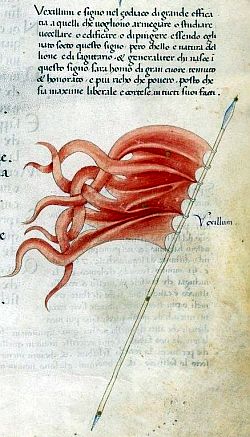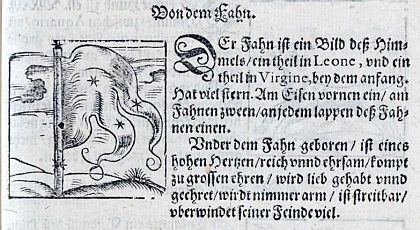
|
|
Star LoreVexillumThe Flag |
|


| Vexillum is a now obsolete constellation created around the year 1225 by Michael Scot. |

|
|
Scottish mathematician and scholar Michael Scot (1175 – c. 1232) is considered by many the greatest
intellectual of his day. Having been a wandering scholar for most of his life, he became science adviser and court astrologer to
the Holy Roman Emperor Frederick II around the year 1225.
 During the Middle Ages, there was no distinction between astronomy and astrology and Scot worked in both fields. As part of his horoscopes, he added two new constellations, Vexillum and Tarabellum to Ptolemy's 48.  Scot describes Vexillum's location as partially in Leo and partially in Virgo with one star in the flag pole, two stars in the flag and one star each at the two tips of the flag.  From the 13th to the 16th century, Vexillum was displayed in European astrological and astronomical manuals as an equal among the constellations of the Zodiac. With the dawn of the Age of Enlightenment and the separation of Astrology and Astronomy, the constellation slowly disappeared.  But even today, the flag is not completely forgotten. Vexillologists (people who study the the history, symbolism and usage of flags) still hold it in high regards, as documented in a 2014 article by The Voice of Vexillology, Flags & Heraldry.  Source: atlascoelestis.com |
 Il Dittamondo, 1355
Il Dittamondo, 1355Source: atlascoelestis.com |

 Astronomia, 1515; atlascoelestis.com
Astronomia, 1515; atlascoelestis.com |
 Himmels Lauf, 1583; atlascoelestis.com
Himmels Lauf, 1583; atlascoelestis.com
|

Roughly one half of today's constellation has its roots in Mesopotamian and
Greek Mythology and was defined by
Ptolemy in the first century.
 The other half was the result of the Age of Discovery in the 15th and 16th century.  In the 1,400 years between these two eras, Scots' creations were the only new constellations in the European sky. |


|
Back to Star Lore |

Back to |
Back to Space Page |
Back to English |
 Back to Start Page |